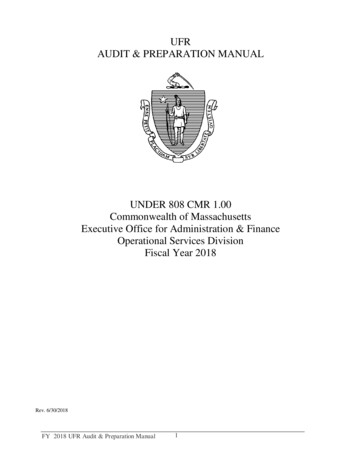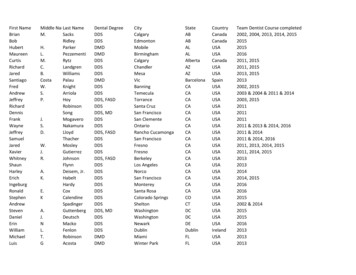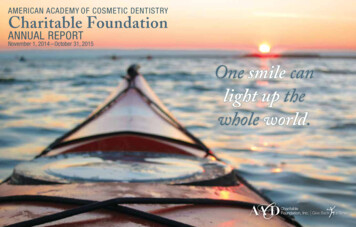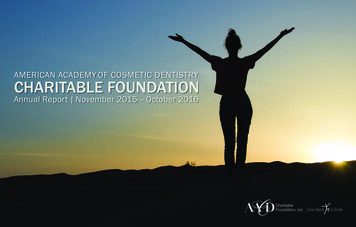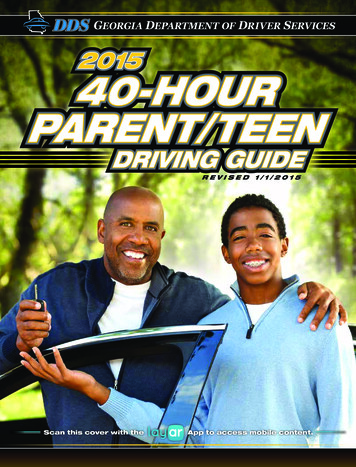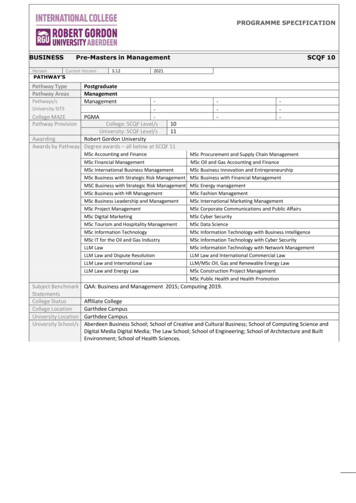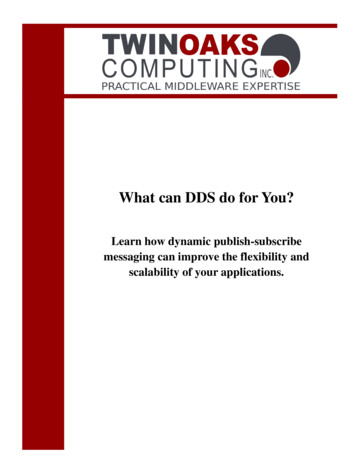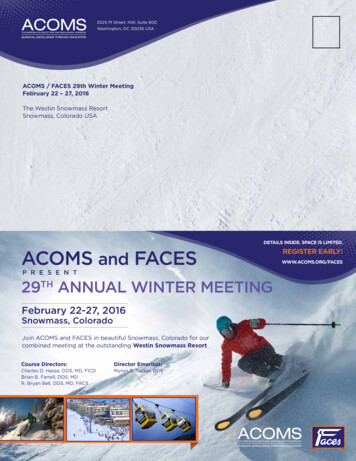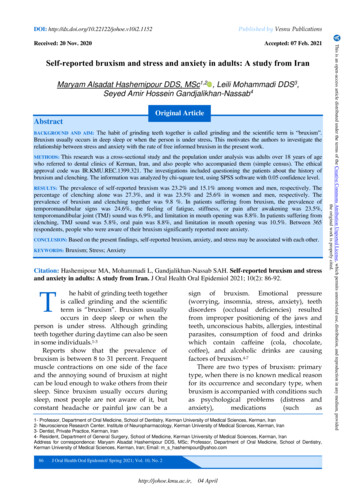
Transcription
Published by Vesnu PublicationsDOI: d: 07 Feb. 2021Self-reported bruxism and stress and anxiety in adults: A study from IranMaryam Alsadat Hashemipour DDS, MSc1,2 , Leili Mohammadi DDS3,Seyed Amir Hossein Gandjalikhan-Nassab4Original ArticleAbstractThe habit of grinding teeth together is called grinding and the scientific term is “bruxism”.Bruxism usually occurs in deep sleep or when the person is under stress. This motivates the authors to investigate therelationship between stress and anxiety with the rate of free informed bruxism in the present work.BACKGROUND AND AIM:This research was a cross-sectional study and the population under analysis was adults over 18 years of agewho referred to dental clinics of Kerman, Iran, and also people who accompanied them (simple census). The ethicalapproval code was IR.KMU.REC.1399.321. The investigations included questioning the patients about the history ofbruxism and clenching. The information was analyzed by chi-square test, using SPSS software with 0.05 confidence level.METHODS:The prevalence of self-reported bruxism was 23.2% and 15.1% among women and men, respectively. Thepercentage of clenching alone was 27.3%, and it was 23.5% and 25.6% in women and men, respectively. Theprevalence of bruxism and clenching together was 9.8 %. In patients suffering from bruxism, the prevalence oftemporomandibular signs was 24.6%, the feeling of fatigue, stiffness, or pain after awakening was 23.5%,temporomandibular joint (TMJ) sound was 6.9%, and limitation in mouth opening was 8.8%. In patients suffering fromclenching, TMJ sound was 5.8%, oral pain was 8.8%, and limitation in mouth opening was 10.5%. Between 365respondents, people who were aware of their bruxism significantly reported more anxiety.RESULTS:CONCLUSION: Based on the present findings, self-reported bruxism, anxiety, and stress may be associated with each other.KEYWORDS:Bruxism; Stress; AnxietyCitation: Hashemipour MA, Mohammadi L, Gandjalikhan-Nassab SAH. Self-reported bruxism and stressand anxiety in adults: A study from Iran. J Oral Health Oral Epidemiol 2021; 10(2): 86-92.The habit of grinding teeth togetheris called grinding and the scientificterm is “bruxism”. Bruxism usuallyoccurs in deep sleep or when theperson is under stress. Although grindingteeth together during daytime can also be seenin some individuals.1-3Reports show that the prevalence ofbruxism is between 8 to 31 percent. Frequentmuscle contractions on one side of the faceand the annoying sound of bruxism at nightcan be loud enough to wake others from theirsleep. Since bruxism usually occurs duringsleep, most people are not aware of it, butconstant headache or painful jaw can be asign of bruxism. Emotional pressure(worrying, insomnia, stress, anxiety), teethdisorders (occlusal deficiencies) resultedfrom improper positioning of the jaws andteeth, unconscious habits, allergies, intestinalparasites, consumption of food and drinkswhich contain caffeine (cola, chocolate,coffee), and alcoholic drinks are causingfactors of bruxism.4-7There are two types of bruxism: primarytype, when there is no known medical reasonfor its occurrence and secondary type, whenbruxism is accompanied with conditions suchas psychological problems (distress andanxiety),medications(suchas1- Professor, Department of Oral Medicine, School of Dentistry, Kerman University of Medical Sciences, Kerman, Iran2- Neuroscience Research Center, Institute of Neuropharmacology, Kerman University of Medical Sciences, Kerman, Iran3- Dentist, Private Practice, Kerman, Iran4- Resident, Department of General Surgery, School of Medicine, Kerman University of Medical Sciences, Kerman, IranAddress for correspondence: Maryam Alsadat Hashemipour DDS, MSc; Professor, Department of Oral Medicine, School of Dentistry,Kerman University of Medical Sciences, Kerman, Iran; Email: m s hashemipour@yahoo.com86J Oral Health Oral Epidemiol/ Spring 2021; Vol. 10, No. 2http://johoe.kmu.ac.ir, 04 AprilThis is an open-access article distributed under the terms of the Creative Commons Attribution Unported License, which permits unrestricted use, distribution, and reproduction in any medium, providedthe original work is properly cited.Received: 20 Nov. 2020
Self-reported bruxismHashemipour et al.antidepressants), or certain illnesses such asParkinsonism or apnea (breathing pausesduring sleep).8 In the secondary type,bruxism will end by resolving the underlyingproblems. Albeit, in some cases, bruxismturns into a habit; in this situation, byeliminating the underlying problem, thehabit will remain. Bruxism usually does nothave a specific sign, but the pressure on theteeth can become high enough causing teethabrasion and removal of the enamel, whichcan increase tooth sensitivity, fraction, andfractures. It can also lead to cuspdegeneration of posterior teeth. In somecases, other signs can be seen, such asheadache, toothache, tooth wear, toothwobbling, degeneration of gums, neck pain,insomnia, ulcers or pain in the cheeks andears, sound during opening and closing ofthe jaw, tooth hypersensitivity, and notchingof the tongue, especially on the sides.8-10In adults who are psychologically normal(i.e., those who do not suffer from anxiety orsevere psychological disorders), the relationshipbetween anxiety and bruxism is still not certain;however, it seems that momentary reactions ofanxiety to high-stress events can be associatedwith self-reported bruxism.11,12This behavior associates with severalfactors such as body movements, heart rateincrease, and changes in breathing andmuscle activity. Many sleep problems,especially frequent waking, have been thesubject of some previous studies. It wasrevealed that anxiety and stress exacerbatedbruxism and other irritations during sleep.Recent studies on media employees whohave various responsibilities and are underthe excessive pressure of irregular workhours show that awareness of bruxism (i.e.,self-reported grinding or clenching duringsleep or when awake) can be a sign of stressor unsatisfaction of the individual regardinghis or her work schedule. Previous studieshave shown that there is no associationbetween gritted teeth and anxiety.12-18 Thismotivates the authors to investigate therelationship between stress and anxiety withthe rate of self-reported bruxism in thepresent work.MethodsThis research was a cross-sectional study andthe population under analysis was adults over18 years of age who referred to dental clinicsof Kerman, Iran, and also people whoaccompanied them (simple census). Theethical approval code was EC/93-51-KNRC.The aim of this research was explained to allof the participants and if they were interested,the questionnaire was given to them by afinal-year student. Besides, they were assuredthat the information would remain discreetand would only be used for statistical studies.In this research, Symptom Checklist-90Revision (SCL-90-R) was used which includes20 questions for anxiety evaluation.18 Thestandard grading to each question is 1 to 5which is given to “very frequently”,“frequently”, “sometimes”, “rarely”, and“never”, and the overall score of thequestionnaire is between 20 to 100. A higherscore is a sign of higher anxiety. Thisquestionnaire was first introduced in 1979 byCooper and Burger based on clinicalexperience and previous psychologicalanalyses. Since then, this test has been used inmany researches and is one of the mostcommon tools for psychiatry diagnosis in theUnited States (US). This questionnaire has beenstandardized by Akhavan Abiri and Shairi inIran.19 Cohen et al. prepared a standard stressquestionnaire to evaluate stress and the level ofstress was measured and expressed by afive-point scale.20 Stress is a situation which anindividual feels pressured, hectic, uptight,anxious or is not able to sleep because ofintellectual preoccupation. The scoring criterionfor each question is 1 to 5 which is given to “notat all”, “very little”, “somewhat”, “a lot”, and“very much” and the overall score of thequestionnaire is variable between 10 to 50.Obtaining a higher score is a sign of higherlevel of anxiety.Self-consciousness of the amount ofpressure or grinding repetition is measured byJ Oral Health Oral Epidemiol/ Spring 2021; Vol. 10, No. 2http://johoe.kmu.ac.ir, 04 April87
Self-reported bruxismHashemipour et al.a five-point scale (never, rarely, sometimes,very often, and always). Individuals whoreported “always” or “very often” werecategorized as frequent bruxers and those whoreported “sometimes” were categorized asmild or non-bruxers. Besides this, questionssuch as “Do you clench your teeth together?”,“Have you or another person heard the soundof your teeth grinding during your sleep?”,“Are your teeth worn more than normal?”,and “Have you experienced any of thefollowing symptoms after waking fromsleep?” were used in order to evaluate selfreported bruxism. Demographic information,such as gender, age, job, and education wasrecorded for the patient. Chi-square test wasused to evaluate the relationship betweendependent variables, while JonckheereTerpstra test was employed to evaluate therelation between the severity of bruxism withstress and anxiety. Multinominal logisticregression model was used to analyze theindependent effects of psychological factorson the possibility of moderate and frequentbruxism. Odds ratios (ORs) and theircorresponding 95% confidence intervals (CIs)were calculated, and statistical analysis wasdone by the SPSS software (version 21, IBMCorporation, Armonk, NY, USA).respectively. The overall percentage ofbruxism and clenching was reported to be9.8% (Table 2).Table 1. Demographic characteristics ofthe subjectsCharacteristicsn (%)Marital statusSingle215 (59.4)Married147 (40.6)JobSelf-employed251 (69.3)Unemployed111 (30.7)EducationIlliterate25 (6.9)High school51 (14.1)diplomaDiploma178 (49.2)Associate degree52 (14.4)Bachelor45 (12.4)Master’s degree or11 (3.0)higherJob scheduleIrregular67 (18.5)Regular184 (50.8)Day215 (59.4)Night36 (9.9)The highest frequency of bruxism wasreported between ages of 40 to 50 years(Table 3); the highest clenching rate wasbetween ages of 20 to 30 years old and theamount was 46.0%. In patients suffering frombruxism, frequency of symptoms such astemporomandibular disorders (TMDs) wasseen in 89 people, fatigue, stiffness, or pain inthe jaw after awakening was seen in85 people, temporomandibular joint (TMJ)sounds in 25 people, and limited mouthopening was seen in 32 people. In patientswith teeth clenching, signs such as TMJsounds were seen in 21 people, oral pain wasseen in 32 people, and limited mouth openingin 38 people. Among patients suffering frombruxism, the major symptoms were oral painand fatigue. The most frequent symptomsamong patients suffering from teethclenching were fatigue, stiffness, or jaw painafter awakening (Table 4).ResultsIn this research, 385 questionnaires weredistributed, of which, 362 were returned(response rate 94.02%). 152 (41.9%) of thesubjects were men and 210 (58.1%) werewomen. The average age of the participantswas 28.14 8.90 years and the range of theirage was between 18 to 74 years old. Table 1shows the demographic information of theparticipants. The response to the questionregarding self-reported bruxism was 23.2%and 15.1% among women and men,Table 2. Absolute and relative abundance of self-reported bruxism and clenchingNeverRarelySometimes OftenAlwaysDo you suffer from bruxism?Do you clench your teeth together?Have you or another person noticed frequentteeth grinding during your sleep?88n (%)n (%)n (%)n (%)n (%)210 (58.1)200 (55.2)235 (64.9)85 (23.5)63 (17.4)50 (13.8)24 (6.6)26 (7.2)22 (6.1)25 (6.9)30 (8.3)28 (7.7)18 (5.0)43 (11.9)27 (7.5)J Oral Health Oral Epidemiol/ Spring 2021; Vol. 10, No. 2http://johoe.kmu.ac.ir, 04 April
Self-reported bruxismHashemipour et al.Table 3. The relationship between demographic variables and the severity of bruxismbased on self-reportsVariableMild or non-bruxer Moderate bruxer Frequent bruxerPGenderAge (year)Irregular working hoursStressAnxiety*PManWoman 3031-4041-5051-60 60YesNoYesNoYesNon (%)n (%)n (%)130 (35.9)165 (45.6)75 (20.0)45 (11.6)152 (42.0)18 (5.0)5 (1.4)27 (7.5)268 (74.0)132 (36.5)163 (45.0)140 (40.1)150 (41.4)10 (2.7)14 (3.8)5 (1.4)6 (1.7)10 (2.8)2 (0.6)1 (0.3)20 (5.5)4 (1.1)16 (4.4)8 (2.2)18 (5.0)6 (1.7)12 (3.6)31 (8.5)5 (1.4)9 (2.5)20 (5.5)6 (1.7)3 (0.8)20 (5.5)23 (6.4)31 (8.6)12 (3.3)32 (8.8)11 (3.0)0.010*0.030*0.0800.001*0.001* 0.05 is significantThere was not any relationship betweenclenching and bruxism with TMDsexcept pain in the temples after awakening(P 0.001).This research indicated that 36 individualssuffered from severe anxiety and 62 individualswere under severe stress. The average scores ofanxiety and stress were 51.12 6.90 and32.15 5.12, respectively. Among 365 peoplewho responded, reports of anxiety weresignificantly higher in individuals who wereaware of bruxism (P 0.001).DiscussionIn this research, the prevalence of bruxismwas 23.2% and 15.1% among men andwomen, respectively, and the frequency ofteeth clenching alone was 27.3%. The highestfrequency of bruxism was seen between agesof 40 to 50 years. Clenching was mostly seenbetween ages of 20 to 30 years with the rateof 46.0%. In various researches, regardingdifferent populations and ages, variableresults about the prevalence of bruxism andteeth clenching have been reported. In thestudy of Winocur et al., the bruxism was14%,21 which is in agreement with Ahlberget al. research which showed that 13.5% ofsubjects claimed to be frequent bruxers.14According to other studies, women havereported higher degrees of bruxismcompared to men;20 however, they are notcompletely compatible with Liddell andLocker study which indicated that menexperienced bruxism more than women.22In Ciancaglini et al. research,23 theprevalence of bruxism was 31.4% and inCarlsson research, the prevalence of bruxismand clenching was 10.0% and 2.0%,24respectively. In Ahlberg et al.18 research, theprevalence of bruxism and clenchingcombined was 20.0%.Table 4. The relative and absolute abundance of temporomandibular signs and the severityof bruxism, based on self-reportYesNoStiffness or pain in the jaw after awakeningJaw pain or teeth locking together after awakeningTemple pain after awakeningLimited mouth opening after awakeningSense of pressure in jaw jointHaving to move the lower jaw for replacementSensing noise in the jaw joint after awakening whichdisappears afterwardsBruxismn (%)Clenchingn (%)Bruxismn (%)Clenchingn (%)85 (23.5)89 (24.6)45 (12.4)32 (8.8)38 (10.5)32 (8.8)25 (6.9)55 (15.2)32 (8.8)32 (8.8)38 (10.5)25 (6.9)28 (7.7)21 (5.8)277 (76.5)273 (75.4)317 (87.6)330 (91.2)324 (89.5)330 (91.2)337 (93.1)307 (84.8)330 (91.2)330 (91.2)324 (94.5)337 (93.1)334 (92.3)341 (94.2)J Oral Health Oral Epidemiol/ Spring 2021; Vol. 10, No. 2http://johoe.kmu.ac.ir, 04 April89
Self-reported bruxismHashemipour et al.In Glaros et al. research,25 the prevalenceof bruxism and clenching combined was over10.0% to 19.0% and in Choi et al.26 research,the prevalence of bruxism was 8.0% andclenching was 9.9%. In Chen et al.27 research,the prevalence of bruxism and clenching was39.4%. In Demir et al.28 research, theprevalence of bruxism was 12.6%, and finallyin Shirani and Maleki29 research, bruxismand clenching were 13.0% and 34.0%,respectively, among a student population.Based on the results of this study, the mostfrequent signs among patients suffering frombruxism were oral pain and fatigue. Inindividuals suffering from teeth clenching, themost frequent signs were fatigue, stiffness, orjaw pain after awakening. However, theseresults need to be further studied. The mostfrequent oral symptom in patients sufferingfrom teeth clenching was tooth wear (42.0%)and the major temporomandibular sign wasjoint clicking (37.5%).In various literature, bruxism andclenching have been considered as possiblefactors for the development of TMDs;30however, in other studies, different resultshave been obtained. In Ciancaglini et al. study,a significant relationship between bruxismand TMDs, especially limited jaw movement,has been shown;23 this is different from theresults of the present study, regarding limitedjaw movement. In Pullinger and Seligman31and also Gavish et al study,32 no relationshipbetween bruxism and TMDs was found.In the present study, a relationshipbetween bruxism and clenching with TMDsexcept temple pain after awakening wasfound. According to a research whichreviewed 63 articles regarding TMDs, therelationship between bruxism and TMDs stillremains uncertain and requires furtherinvestigation.33 Among 365 respondents,those who were aware of bruxism reportedsignificantly more anxiety. Severe anxietyand stress both had a significant relationshipwith frequent bruxing. Regression analysisindicated a significant relationship betweensevere stress and bruxism, which is similar to90the original study. It is worth mentioning thatthe definition of bruxism in this study wasbased on self-reported bruxism and was notclinically confirmed.In two other researches which studiedbruxism in individuals who routinelyexperienced higher levels of stress, theprevalence among Brazilian police was50.0%34 and among Israeli air force pilots was69.0%.35 Lavigne et al. suggested that theresult of the questionnaires may be biasedbecause of natural fluctuations in bruxismactivity with time, risk of false or poormemory of bruxism, or anxiety andunawareness of this habit.36In this study, bruxism was mostlyreported between ages of 40 to 50, whileseveral studies have reported that peoplewith anxiety have a higher risk of bruxism atany age.8,34,35,37 Some other studies were notable to confirm this relationship.36,38 In thepresent research work, a clear difference isfound between frequent bruxers with mild ornon-bruxers regarding their anxiety andstress scores, which is similar to the result ofAhlberg et al.14In the adult population who arepsychologically healthy (i.e., individuals whodo not have severe anxiety or psychologicaldisorders), the relationship between anxietyand bruxism is still not certain. However, itseems that transient anxiety reactions tohigh-stress events can be associated withself-reported bruxism.39 It has been shownthat sleep bruxism is a part of compleximpulse reaction in the central nervous system(CNS) which occurs during sleep depthfluctuations and is accompanied with bodymovement, heart rate increase, respiratorychanges, and muscle activity. Since theprevalence of sleep disorders, especiallyfrequent awakening, was seen in the previousstudies, it is possible that anxiety and stressincrease bruxism activity and other impulsesduring sleep. The fact that this includesself-reported bruxism is still not clear.12Recent studies on multimedia employeeswho have several responsibilities and areJ Oral Health Oral Epidemiol/ Spring 2021; Vol. 10, No. 2http://johoe.kmu.ac.ir, 04 April
Self-reported bruxismHashemipour et al.under the pressure of irregular working hours,sever and constant changes of technology, anddeadline and demands regarding livebroadcasting indicate that self-consciousnessof bruxism can be a sign of stress anddissatisfaction of their work schedule;13however, previous studies have not controlledanxiety and the intensity of bruxism.14Current results confirm studies regardingthe relationship between bruxism and anxietyin adults. Except Ohayon et al. study whichwas performed on a large population and theresults were different.40 Study of literatureshows that awake bruxism may be mostlyassociated with psychological factors andpsychopathologiccomplications,whileinformation about the aetiology obtained insleep laboratories did not confirm therelationship between psychosocial disordersand bruxism which was diagnosed withpolysomnography (PSG).10Clinical diagnostic methods are used forresearches performed on large samplesregarding bruxism. In a recent work byManfredini and Lobbezoo, the majority ofinformation regarding the relationshipbetween psychological symptoms andbruxism was obtained by clinical and/orself-reported bruxism.9 Moreover, unlike PSGstudies, this study found a relationshipbetween bruxism and psychological disorders.Studies have shown that questionnaires(which have also been used in this study) y of self-reported questionnaires mustbe proven by PSG studies on sleep bruxismand electromyographic (EMG) recordings onawaked bruxism, performed by a portableapparatus.20This study has some limitations. One isLack of cooperation of a number of peopleand the other is failure to perform clinicalexamination of patients.ConclusionBased on the present findings, self-reportedbruxism, anxiety, and stress may beassociated with each other.Conflict of InterestsAuthors have no conflict of interest.AcknowledgmentsThe authors would like to appreciate thecontinued support of Neuroscience ResearchCenter, Institute of Neuropharmacology,Kerman University of Medical Sciences,Kerman, Iran.References1. Wassell R, Naru A, Steele J, Nohl F. Applied occlusion. London, UK: Quintessence; 2008. p. 26–30.2. Manfredini D, Winocur E, Guarda-Nardini L, Paesani D, Lobbezoo F. Epidemiology of bruxism in adults:A systematic review of the literature. J Orofac Pain 2013; 27(2): 99-110.3. Shetty S, Pitti V, Satish Babu CL, Surendra Kumar GP, Deepthi BC. Bruxism: A literature review. J IndianProsthodont Soc 2010; 10(3): 141-8.4. Lobbezoo F, van der Zaag J, van Selms MK, Hamburger HL, Naeije M. Principles for the management of bruxism.J Oral Rehabil 2008; 35(7): 509-23.5. Lobbezoo F, van der Zaag J, Naeije M. Bruxism: its multiple causes and its effects on dental implants - an updatedreview. J Oral Rehabil 2006; 33(4): 293-300.6. Persaud R, Garas G, Silva S, Stamatoglou C, Chatrath P, Patel K. An evidence-based review of botulinum toxin(Botox) applications in non-cosmetic head and neck conditions. JRSM Short Rep 2013; 4(2): 10.7. Scully C. Oral and maxillofacial medicine: The basis of diagnosis and treatment. Edinburgh, UK: ChurchillLivingstone; 2008. p. 291-2, 343, 353, 359, 382.8. Lobbezoo F, Naeije M. Bruxism is mainly regulated centrally, not peripherally. J Oral Rehabil 2001; 28(12): 1085-91.9. Manfredini D, Lobbezoo F. Role of psychosocial factors in the etiology of bruxism. J Orofac Pain 2009; 23(2): 153-66.10. Pettengill CA. Interaction of dental erosion and bruxism: The amplification of tooth wear. J Calif Dent Assoc 2011;39(4): 251-6.11. Huynh N, Kato T, Rompre PH, Okura K, Saber M, Lanfranchi PA, et al. Sleep bruxism is associated to microarousals and an increase in cardiac sympathetic activity. J Sleep Res 2006; 15(3): 339-46.12. Ahlberg K, Jahkola A, Savolainen A, Kononen M, Partinen M, Hublin C, et al. Associations of reported bruxismwith insomnia and insufficient sleep symptoms among media personnel with or without irregular shift work. HeadJ Oral Health Oral Epidemiol/ Spring 2021; Vol. 10, No. 2http://johoe.kmu.ac.ir, 04 April91
Awareness of edentulous patients about implant treatmentSafari et al.Face Med 2008; 4: 4.13. Ahlberg J, Rantala M, Savolainen A, Suvinen T, Nissinen M, Sarna S, et al. Reported bruxism and stress experience.Community Dent Oral Epidemiol 2002; 30(6): 405-8.14. Ahlberg K, Ahlberg J, Kononen M, Partinen M, Lindholm H, Savolainen A. Reported bruxism and stress experiencein media personnel with or without irregular shift work. Acta Odontol Scand 2003; 61(5): 315-8.15. Elo AL, Leppanen A, Jahkola A. Validity of a single-item measure of stress symptoms. Scand J Work EnvironHealth 2003; 29(6): 444-51.16. Sjoholm TT, Piha SJ, Lehtinen I. Cardiovascular autonomic control is disturbed in nocturnal teethgrinders. ClinPhysiol 1995; 15(4): 349-54.17. de la Hoz-Aizpurua JL, Diaz-Alonso E, LaTouche-Arbizu R, Mesa-Jimenez J. Sleep bruxism. Conceptual reviewand update. Med Oral Patol Oral Cir Bucal 2011; 16(2): e231-e238.18. Ahlberg J, Lobbezoo F, Ahlberg K, Manfredini D, Hublin C, Sinisalo J, et al. Self-reported bruxism mirrors anxietyand stress in adults. Med Oral Patol Oral Cir Bucal 2013; 18(1): e7-11.19. Akhavan Abiri F, Shairi MR. Validity and reliability of Symptom Checklist-90-Revised (SCL-90-R) and BriefSymptom Inventory-53 (BSI-53). Clinical Psychology and Personality 2020; 17(2): 169-95. [In Persian].20. Cohen S, Doyle WJ, Skoner DP. Psychological stress, cytokine production, and severity of upper respiratory illness.Psychosom Med 1999; 61(2): 175-80.21. Winocur E, Uziel N, Lisha T, Goldsmith C, Eli I. Self-reported bruxism - associations with perceived stress,motivation for control, dental anxiety and gagging. J Oral Rehabil 2011; 38(1): 3-11.22. Liddell A, Locker D. Gender and age differences in attitudes to dental pain and dental control. Community DentOral Epidemiol 1997; 25(4): 314-8.23. Ciancaglini R, Gherlone EF, Radaelli G. The relationship of bruxism with craniofacial pain and symptoms from themasticatory system in the adult population. J Oral Rehabil 2001; 28(9): 842-8.24. Carlsson GE, Egermark I, Magnusson T. Predictors of bruxism, other oral parafunctions, and tooth wear over a 20year follow-up period. J Orofac Pain 2003; 17(1): 50-7.25. Glaros AG, Tabacchi KN, Glass EG. Effect of parafunctional clenching on TMD pain. J Orofac Pain 1998; 12(2):145-52.26. Choi YS, Choung PH, Moon HS, Kim SG. Temporomandibular disorders in 19-year-old Korean men. J OralMaxillofac Surg 2002; 60(7): 797-803.27. Chen YQ, Cheng HJ, Yu CH, Gao Y, Shen YQ. Epidemic investigation on 3 to 6 years children's bruxism inShanghai. Shanghai Kou Qiang Yi Xue 2004; 13(5): 382-4. [In Chinese.]28. Demir A, Uysal T, Guray E, Basciftci FA. The relationship between bruxism and occlusal factors among seven- to19-year-old Turkish children. Angle Orthod 2004; 74(5): 672-6.29. Shirani AM, Maleki L. Relation of oral parafunction habits and signs and symptoms of temporomandibulardisorders. J Isfahan Dent Sch 2007; 2(4): 35-40. [In Persian].30. Blasberg B, Greenberg MS. Temporomandibular disorders. In: Greenberg MS, Glick M, Ship JA, editor. Burket'soral medicine. 11th ed. Hamilton, ON: BC Decker Inc; 2015. p. 223-55.31. Pullinger AG, Seligman DA, Gornbein JA. A multiple logistic regression analysis of the risk and relative odds oftemporomandibular disorders as a function of common occlusal features. J Dent Res 1993; 72(6): 968-79.32. Gavish A, Halachmi M, Winocur E, Gazit E. Oral habits and their association with signs and symptoms oftemporomandibular disorders in adolescent girls. J Oral Rehabil 2000; 27(1): 22-32.33. Barbosa TS, Miyakoda LS, Pocztaruk RL, Rocha CP, Gaviao MB. Temporomandibular disorders and bruxism inchildhood and adolescence: Review of the literature. Int J Pediatr Otorhinolaryngol 2008; 72(3): 299-314.34. Carvalho AL, Cury AA, Garcia RC. Prevalence of bruxism and emotional stress and the association between themin Brazilian police officers. Braz Oral Res 2008; 22(1): 31-5.35. Lurie O, Zadik Y, Einy S, Tarrasch R, Raviv G, Goldstein L. Bruxism in military pilots and non-pilots: Tooth wearand psychological stress. Aviat Space Environ Med 2007; 78(2): 137-9.36. Lavigne GJ, Khoury S, Abe S, Yamaguchi T, Raphael K. Bruxism physiology and pathology: An overview forclinicians. J Oral Rehabil 2008; 35(7): 476-94.37. Restrepo CC, Vasquez LM, Alvarez M, Valencia I. Personality traits and temporomandibular disorders in a group ofchildren with bruxing behaviour. J Oral Rehabil 2008; 35(8): 585-93.38. Rompre PH, Daigle-Landry D, Guitard F, Montplaisir JY, Lavigne GJ. Identification of a sleep bruxism subgroupwith a higher risk of pain. J Dent Res 2007; 86(9): 837-42.39. Manfredini D, Fabbri A, Peretta R, Guarda-Nardini L, Lobbezoo F. Influence of psychological symptoms on homerecorded sleep-time masticatory muscle activity in healthy subjects. J Oral Rehabil 2011; 38(12): 902-11.40. Ohayon MM, Li KK, Guilleminault C. Risk factors for sleep bruxism in the general population. Chest 2001; 119(1):53-61.92J Oral Health Oral Epidemiol/ Spring 2021; Vol. 10, No. 2http://johoe.kmu.ac.ir, 04 April
Maryam Alsadat Hashemipour DDS, MSc1,2, Leili Mohammadi DDS3, Seyed Amir Hossein Gandjalikhan-Nassab4 Abstract BACKGROUND AND AIM: The habit of grinding teeth together is called grinding and the scientific term is "bruxism". Bruxism usually occurs in deep sleep or when the person is under stress. This motivates the authors to investigate the
